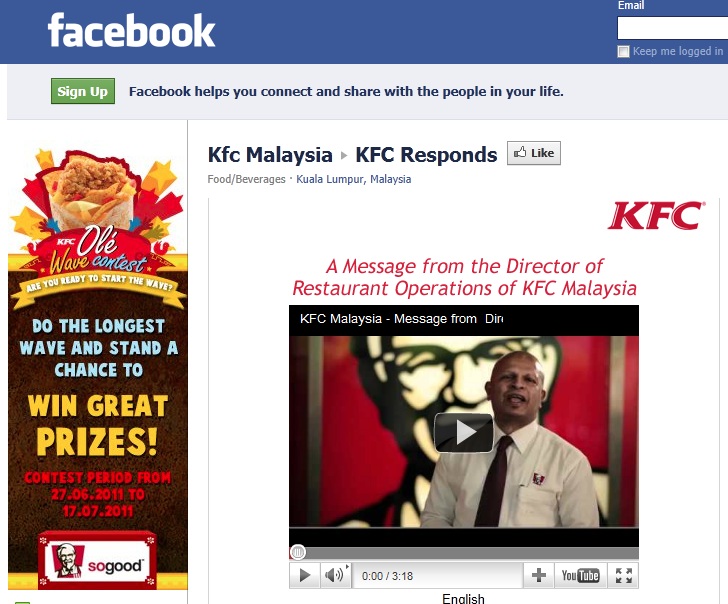SOCIAL MEDIA CASE STUDY: How KFC nailed a crisis with good communications
A few weeks ago, we laid out MRM’s eight step plan for dealing with a social media crisis.
In our short film we described how pizza firm Domino’s had suffered significant brand damage when a rogue employee posted films of colleagues doing disgusting things with the food before serving it.
Domino’s didn’t have a clue what to do and the film went viral across the globe. It was a PR disaster.
It’s amazingly easy to find case studies that highlight abject failure in handling brand crises through calm, deliberate communications (News International, anyone?).
So we’re pleased to be able to bring to you a real life ‘how it should be done’ case study that is only coming to end at the time of writing this.
Follow Michael Taggart on Twitter for more social media crisis management insights
It’s a good one to compare to the Domino’s case study because it’s about another fast food firm that encountered an almost identical crisis.
KFC Malaysia found itself in hot water when a member of staff shot footage of a colleague tampering with the food. This film was sent anonymously to the KFC headquarters and the police were called in. An internal investigation was also launched and the issue was dealt with at an HR level.
So far, so good.
But then the inevitable happened. Three weeks ago, on June 25, the video below was leaked onto YouTube.
[youtube]http://www.youtube.com/watch?v=SY3Hungma8s[/youtube]
MRM’s first crisis communications rule is to listen, our second is to assess the level of threat and our third is to act quickly if steps one and two tell you that you should.
KFC lost no time going through this process, deciding very quickly that they needed to respond.
And, boy, did they respond.
Our step six advocates creating a dedicated online space to deal with any crisis when there is a risk of comments swamping a blog, Twitterfeed or Facebook page that is designed for other purposes, such as customer support, sales or customer feedback. The first thing KFC did was set up an area within their Facebook page entitled “KFC responds” (pictured below), ensuring they could take control of the crisis by preventing it from stifling other important communications activities.

The page contains an FAQ anticipating all the questions that were likely to come up and, in a real sign KFC had learnt from the mistakes of Domino’s (or watched our film!), they uploaded two videos featuring the chain’s Director of Restaurant Operations, Mohammed Alwi, and made them available on YouTube. We said one of the biggest mistakes Domino’s made was to respond to a viral YouTube video with a press release. If YouTube is where the action is, we said, then it makes sense to respond using film.
This is why our step four is ‘fish where the fish are’ and this is exactly what KFC did.
MRM’s crisis communications kit also says “the absolute key is planning…failing to plan is planning to fail”. It is abundantly clear KFC had thought ahead about crisis communications because the video is available in both Malay and English, an obvious but essential step to ensure they didn’t further enrage customers by excluding them from their communications.
The film contains an apology and goes on to describe the steps that have already been taken in order to help reassure customers that this sort of issue won’t reoccur. They explain how (a) cameras have been installed in kitchens of all KFC outlets in Malaysia, (b) all kitchen preparation staff are now going to be directly supervised and (c) the firm is providing hygiene training for staff. Take a minute to watch it – it’s text book crisis communications.
[youtube]http://www.youtube.com/watch?v=ZY-Xlc8rark[/youtube]
MRM’s seventh step advises that firms redirect the anger of the mob, putting people’s passion to constructive use by asking for their advice about what to do. This is exactly what KFC has done, proactively inviting upset citizens to express their concerns on the Facebook page in a way that might help the chain learn from the kerfuffle.
The result?
A few days later, the number of negative comments are starting to fall away and it looks like this will come to a comfortable and dignified close for KFC in Malaysia.
The only step from MRM’s plan that the firm has yet to enact is to follow through. So it will be interesting to see whether we’ll hear from KFC in a few weeks or months about what it has learnt, whether the restaurant chain will thank members of the public who got involved and whether KFC’s bosses will tell us how the changes they implemented have helped the business.
So it’s top of the class to KFC for text book crisis communications management and we’re glad they were able to make use of MRM’s eight step plan 😉
RELATED POST: ‘Eight steps to excel in a social media crisis’, ‘Green tea caffeine’
